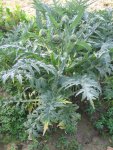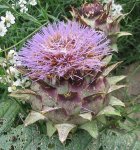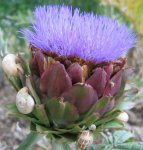Artichoke - cynara scolymus l.
Family Asteraceae - Compositae
Botanical characteristics. Perennial or biennial herbaceous plant up to 2 m high. Introduced into the culture. Artichoke is grown as a vegetable and medicinal plant. Numerous varieties are distinguished by the size of the plants, the shape and structure of the leaves, and the periods of ripening of the inflorescences. Baskets are round, oval, conical, coloring them from green to dark purple. Leaves pinnately dissected with serrated or lobate segments, sometimes prickly, with pubescent pubescence, green or grayish-green. Single baskets on the top of the stems and branches, with a fleshy floret and large juicy numerous leaves of the wrapper. Marginal flowers are false tongue, middle, tubular. Achenes are large, gray with dark strips or mottled with a hard shell.Used parts of the plant. The medicinal raw material is the whole plant, but most often the baskets. Inflorescences are used when the top leaves of the wrapper begin to diverge. They are cut with the tip of the stem and kept in the cold before use. The leaves are collected during the flowering of the plant; Roots - in the autumn. Immediately after the collection of raw materials, all kinds of preparations are prepared from it, the juice is preserved for storage for future use. After drying, the plant loses a significant part of its medicinal properties.
Chemical composition. All parts of the plant contain a large set of vitamins, microelements, carbohydrates: inulin; Proteins, flavonoids, tannins. Due to the large content of vitamins, cinaropicrin, cinnarin, carotene, artichoke preparations are recommended for elderly people with atherosclerosis. Tsinarin has choleretic, diuretic antihepatopathological properties.
Application. In the experiment, galenic preparations have a beneficial effect on liver function, stimulate the formation and outflow of bile.
Infusions and decoctions of leaves and inflorescences are used for nausea, flatulence, with pain caused by a decreased function of the liver, with gallstones, colic of the gastrointestinal tract. Artichoke medications reduce the fat and cholesterol levels in the blood. Recently, there have been reports in the literature about the use of artichoke in blood diseases, and also as an antitumor agent.
In folk medicine artichoke has long been used as an analgesic after severe illnesses, both choleretic and in kidney diseases. It is used in a raw and canned form with constipation, scurvy, allergic conditions, skin diseases.
The tender artichoke pulp has a very pleasant taste, is a dietary product for many diseases, especially in diabetes mellitus.
Preparation
- For infusion take 30 g of fresh leaves, pour 300 ml of boiling water, insist on a boiling water bath for 15 minutes, cool for 45 minutes, filter. Take 100 ml 3 times daily before meals.
- For broth take 50 g of fresh inflorescences, pour 300 ml of boiling water, insist on a boiling water bath for 30 minutes, cool for 10 minutes, without removing from the bath, filter. Take 100 ml 3 times daily before meals.





Comments
When commenting on, remember that the content and tone of your message can hurt the feelings of real people, show respect and tolerance to your interlocutors even if you do not share their opinion, your behavior in the conditions of freedom of expression and anonymity provided by the Internet, changes Not only virtual, but also the real world. All comments are hidden from the index, spam is controlled.